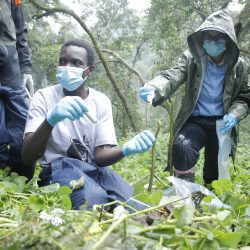INFECTIOUS DISEASES: Safeguarding the Future for Mountain Gorillas
Blog | 6/03/20
Call for Certified Gorilla FriendlyTM standards to be put in practice at all mountain gorilla sites in Rwanda, Uganda and the Democratic Republic of Congo
Human-borne diseases pose one of the most serious threats to the survival of the world’s endangered mountain gorillas.
The latest strain of corona virus that is sweeping the globe is a stark reminder of how quickly a disease can progress from a localized outbreak to a global concern. It underlines the importance of taking every possible precaution to prevent the rapid spread of life-threatening infections.
This same precautionary principle should also guide our approach to disease prevention where mountain gorillas are concerned, and not just in the context of COVID-19.
Like other great apes, mountain gorillas, with which we share around 98% of our DNA,are highly susceptible to human-borne diseases. Even a common cold, which is little more than a temporary inconvenience for humans, can prove fatal to them.

As per the advisory from partner Gorilla Doctors, the best way to protect endangered mountain gorillas is to minimize direct and indirect contact between gorillas and people infected with COVID-19 and other infectious diseases.
Keeping a safe distance between visitors and mountain gorillas is an important common-sense guideline, and this should be at least 10 meters or more. An extra, and necessary, precaution is the use of a surgical mask or other forms of protective barrier, to cover the nose and mouth throughout the one-hour encounter with a gorilla group.
The International Gorilla Conservation Programme (IGCP) and its coalition partners Conservation International, Fauna & Flora International, and WWF have become increasingly concerned that these simple precautions are not being universally observed across parks hosting mountain gorillas in Rwanda, Uganda and the Democratic Republic of Congo (DRC). This needs to change to avoid a potential disaster.
An encounter with a mountain gorilla group is no doubt an unforgettable, life-enhancing experience, and a rare privilege. We urge all those who are fortunate enough to visit these charismatic great apes to make gorilla welfare their number one priority, not only for the sake of the gorillas themselves, but also to ensure that others are afforded the same privilege for generations to come.
For this reason, IGCP has partnered with Wildlife Friendly Enterprise Network on the Certified Gorilla FriendlyTM initiative and is working with park authorities, managers, and staff to embed good practices into the day-to-day management of tourism in mountain gorilla sites. The standards are based on established IUCN best practice standards and expert opinion based on new developments.
Further, the use of masks or other protective barriers is a recommended standard under the Certified Gorilla FriendlyTM initiative and should be made standard practice throughout the relevant national parks in Rwanda and Uganda, as is already practice in the DRC.

Responsible tourism is a cornerstone of mountain gorilla conservation and crucial to their survival. It is the lifeblood of the national parks and generates vital revenue to support the human needs and aspirations of nearby communities.
But it’s a delicate balancing act, and the welfare of the gorillas must be paramount in all interactions between tourists and apes. There is no room for complacency.



